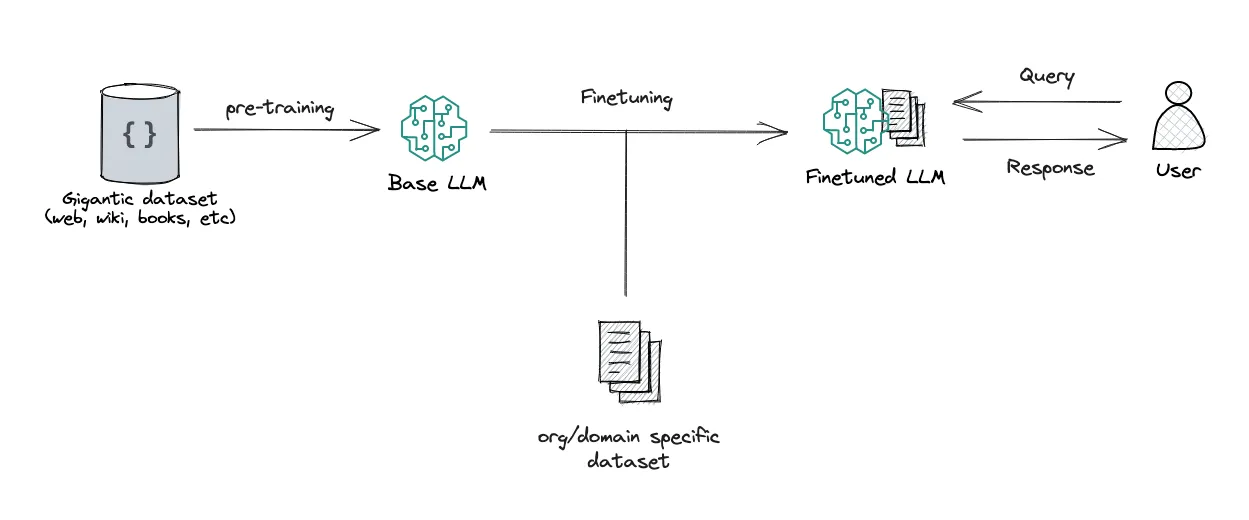Large Language Models (LLMs) are reshaping how we interact with technology, making tasks like text classification, document summarization, and content generation more efficient across industries. These models, trained on vast datasets, can be further refined with smaller, domain-specific data to tackle specialized challenges in fields like retail and finance.
Understanding Large Language Models
The “large” in LLMs refers to both their massive training datasets and the extensive number of parameters or hyperparameters they contain. These parameters act as the model’s “memory” and “knowledge,” shaping its ability to predict text and perform language-related tasks.
LLMs go through a two-step training process:
- Pre-training: The model learns general language understanding from a vast corpus of text data.
- Fine-tuning: The pre-trained model is adapted for specific tasks or industries, such as finance or healthcare, using a smaller, focused dataset.
Key Benefits of Large Language Models
1. Multitasking
LLMs can handle multiple language-related tasks, such as answering questions, generating content, and analyzing sentiment, all within a single model.
2. Minimal Data for Fine-Tuning
Thanks to few-shot and zero-shot learning, LLMs can perform well on new tasks with minimal or even no explicit training data.
3. Continual Performance Improvement
With ongoing research and enhancements, LLMs continue to improve in accuracy, efficiency, and adaptability.
Prompt Engineering: Optimizing Model Performance
Prompt design plays a crucial role in leveraging LLMs effectively. It involves crafting clear instructions and providing relevant context to guide the model’s responses.
Prompt Engineering is the practice of refining prompts to optimize model performance. Key strategies include:
- Incorporating domain-specific knowledge.
- Providing examples of desired outputs.
- Using precise keywords to shape responses.
Types of Language Models
1. Generic Language Models
These models predict the next word based on learned patterns from the training data.
2. Instruction-Tuned Models
These models are fine-tuned to follow explicit instructions in the input, making them more responsive and structured.
3. Dialog-Tuned Models
A specialized subset of instruction-tuned models, these are designed for conversational interactions. They respond naturally to dialogue-style inputs, making them ideal for chatbots and virtual assistants.

Efficient Fine-Tuning Methods
Although fine-tuning an LLM for a particular task can require a lot of resources, there are more affordable options available with parameter-efficient tuning techniques. By adding tiny, trainable layers that can be switched in and out during inference, these techniques preserve the fundamental model while allowing for flexibility rather than changing the entire model.
Leveraging Google Cloud’s Generative AI Tools
1. Gen AI Studio
Google Cloud’s Gen AI Studio allows developers to customize LLMs for their applications with a suite of tools for training and deployment.
2. Gen AI App Builder
This tool enables developers to create AI-driven applications using a visual editor with built-in search capabilities. It simplifies the process of building chatbots, custom search engines, and digital assistants without requiring extensive coding expertise.
Conclusion
The advent of Large Language Models is not merely an incremental step in AI development. It represents a seismic shift, fundamentally reshaping the landscape of AI applications across diverse sectors.
From automating complex customer service interactions to accelerating research and development in scientific fields, Large Language Models are proving to be invaluable assets. The power of these models, however, is not fully realized through their inherent capabilities alone.
The strategic application of prompt engineering, meticulously crafted to elicit specific responses, and the implementation of sophisticated fine-tuning processes, tailored to nuanced industry needs, are crucial for businesses to unlock their maximum potential. These techniques empower firms to leverage Large Language Models for highly specialized tasks, ensuring accuracy, relevance, and efficiency.
Furthermore, the democratization of Large Language Models technology is being accelerated by intuitive platforms like Gen AI Studio and Gen AI App Builder. These tools are significantly lowering the barriers to entry, enabling organizations of all sizes to seamlessly integrate Large Language Models into their existing workflows.
By simplifying the process of creating and deploying bespoke AI solutions, these platforms are fostering an environment of innovation and experimentation. No longer confined to the realm of research labs, Large Language Models are now readily accessible for real-world applications.
This accessibility is driving transformative change and creating unprecedented opportunities for businesses to enhance their operations, improve customer experiences, and gain a competitive edge in an increasingly data-driven world.
The ability to customize and deploy these powerful Large Language Models with ease marks a new era in AI, where the potential for innovation is limited only by the imagination. The future of many businesses will now rely on how well they integrate and utilize Large Language Models within their daily operations.
check out more Blogs – Click Here
Visit our LinkedIn Page – Click Here
